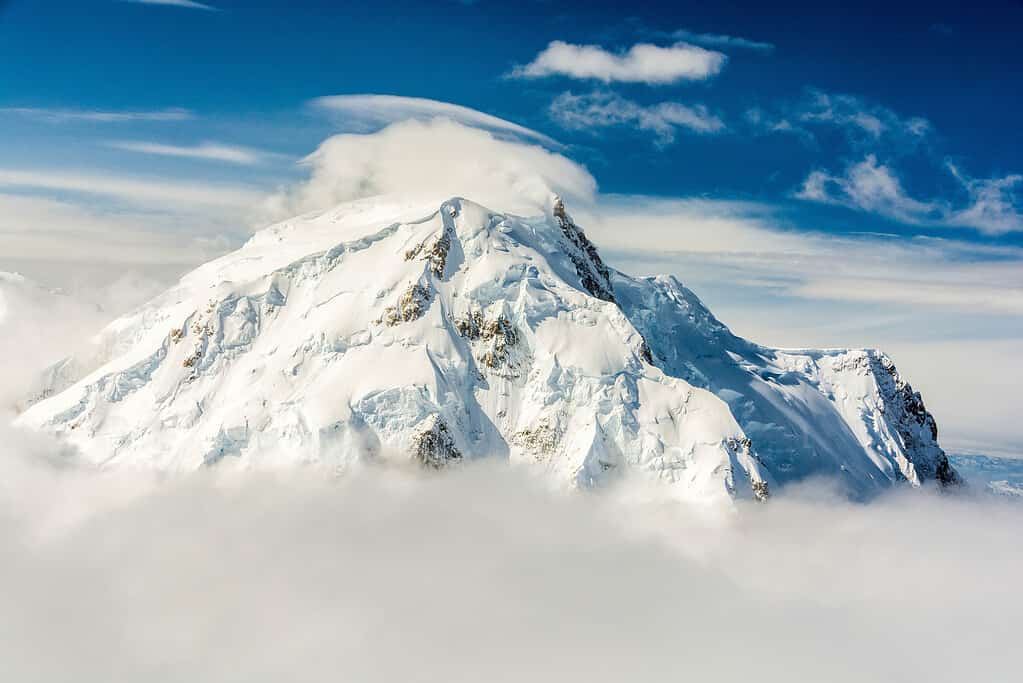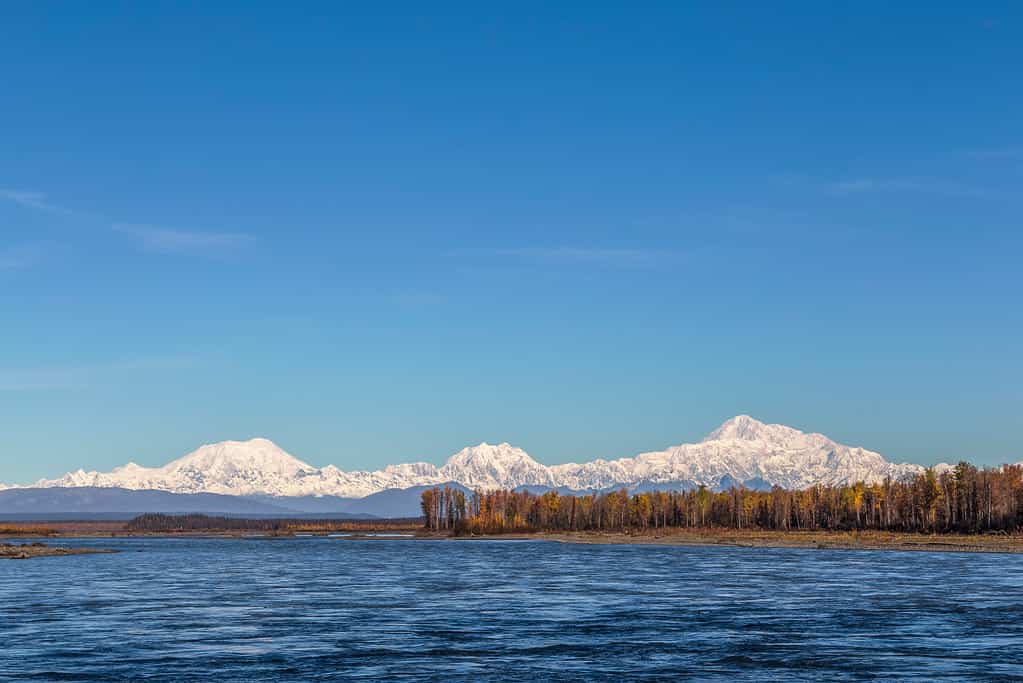In the shadow of Denali stands a towering testament to resilience. Mount Foraker, the second-highest peak in Alaska, sits beneath the grandeur that captures the world’s gaze. Mount Foraker is known to natives as Menlale, which translates to “Denali’s wife.” Alternatively, she is referred to as Sultana, meaning “the woman.” And when you discover just how tall Mount Foraker really is, you’ll be amazed. At an astounding 17,400 feet (5304 m) tall, Mount Foraker deserves a little more respect and recognition. But as younger sons and maids of honor understand, sometimes you have to settle for second best. Continue reading to discover the second-tallest peak in Alaska!

Mount Foraker is the second-highest peak in Alaska.
©Bob Pool/Shutterstock.com
Discover Just How Tall Mount Foraker Really Is: Overview
Mount Foraker is the second-highest peak in the Alaska Range, located in Denali National Park and Preserve in Alaska. Mount Foraker is part of the Alaska Range, a massive mountain range that runs through the Southern part of Alaska. The highest peak in North America, Denali (formerly known as Mount McKinley), is located 14 miles (23 kilometers) to the southwest. Mount Foraker stands at an elevation of 17,400 feet (5,304 m) above sea level, making it the second-highest peak in the Alaska Range and the third highest in North America, after Denali and Mount Logan in Canada’s Yukon Territory. Lieutenant J.S. Herron of the U.S. Army renamed the mountain in 1899 in honor of Joseph B. Foraker, a senator from Ohio. Senator Foraker strongly advocated for Alaska’s development. Sultana and Menlale are the original Native American names for the mountain. Mount Foraker is a mecca for mountaineering.
Climbing Mount Foraker
Its challenging and technical climbing routes are a hallmark of the mountain. Mount Foraker’s steep slopes and unpredictable weather conditions make it a formidable climb. The most popular route is the West Ridge, on which climbers often face extreme cold, high winds, and avalanches. Due to its difficulty, climbing Mount Foraker requires advanced mountaineering skills, and climbers often spend several weeks on the mountain.

Mount Foraker’s steep slopes and unpredictable weather conditions make it a formidable climb.
©Jesse campo/Shutterstock.com
American climbers Charles Houston, T. Graham Brown, and Chychele Waterston made the first successful ascent of Mount Foraker in 1934. Some of the notable routes on Mount Foraker include the West Ridge, Infinite Spur, and the Southeast Ridge. The Infinite Spur is particularly famous for its steepness and level of difficulty. Over the years, many climbers and mountaineers have attempted to summit Mount Foraker. Notable expeditions and climbers include Bradford Washburn, Fred Beckey, and the 2006 Russian team led by Dmitry Golovchenko, which made a remarkable ascent of the Infinite Spur. Mount Foraker’s challenging nature and stunning beauty make it an appealing destination for experienced mountaineers seeking a formidable climbing challenge in one of the most remote and pristine wilderness areas of North America.
Wildlife
Mount Foraker is located within the boundaries of Denali National Park and Preserve, a vast wilderness area known for its diverse wildlife, including grizzly bears, wolves, moose, and various bird species. The area is not known for fishing. Lakes and streams in the area typically contain a lot of glacial silt. The silt constitutes a poor habitat for fish. Hunting is not permitted within the National Park but is allowed within the Preserve. It is, however, subject to a number of rules and regulations. The mountain’s remote location and challenging terrain contribute to its pristine and untouched environment Because Mount Foraker is located within Denali National Park and Preserve, it is subject to strict conservation regulations.

Mount Foraker’s remote location and challenging terrain contribute to its pristine environment.
©Dara J/Shutterstock.com
Relatively Speaking
How does the penultimate Mount Foraker stack up to the ultimate peaks in other states? How does it compare to the highest peaks in other parts of the world? As you will see, being second-best in one location is often better than coming in first in another.
| Peak/Location: | Height: |
|---|---|
| Mount Everest, border of China and Nepal, the highest peak on Earth: | 29,032 feet (8,849 m) |
| Denali, (formerly Mount McKinley), the tallest peak in Alaska: | 20,310 feet (6,190 m) |
| Mount Foraker (formerly Menlale and Sultana), Alaska: | 17,400 feet (5304 m) |
| Mount Elbert, Colorado – the highest peak in Colorado: | 14,505 feet (4421 m) |
| Mount Elbert, Colorado – highest peak in Colorado: | 14,440 feet (4401.2 m) |
| Mount Rainier, the highest peak in Washington State: | 14,417 feet (4394 m) |
| Mount Kea, the highest peak in Hawaii: | 13,803 feet (4207.3 m) |
| Gannett Peak, the highest mountain in Wyoming: | 13,810 feet (4,210 m) |
| Kings Peak, the highest mountain in Utah: | 13,534 feet (4125 m) |
| Wheeler Peak, the highest mountain in New Mexico: | 13,167 feet (4013.3 m) |
| Granite Peak, the highest natural point in Montana: | 12,807 feet (3,904 m) |
Thank you for reading! Have some feedback for us? Contact the AZ Animals editorial team.








